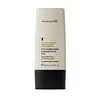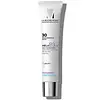What's inside
What's inside
 Key Ingredients
Key Ingredients

 Benefits
Benefits

 Concerns
Concerns

 Ingredients Side-by-side
Ingredients Side-by-side

Zinc Oxide
Cosmetic ColorantWater
Skin ConditioningIsododecane
EmollientCaprylic/Capric Triglyceride
MaskingCoco-Caprylate/Caprate
EmollientAcrylates Copolymer
C12-15 Alkyl Benzoate
AntimicrobialButyloctyl Salicylate
Skin ConditioningPolyglyceryl-4 Diisostearate/Polyhydroxystearate/Sebacate
EmulsifyingGlycerin
HumectantPropanediol
SolventCannabis Sativa Seed Oil
EmollientSodium Chloride
MaskingPolyhydroxystearic Acid
EmulsifyingCannabidiol - Synthetically Produced
AntioxidantTriheptanoin
Skin ConditioningStearalkonium Hectorite
Gel FormingCalendula Officinalis Flower Extract
MaskingStearoyl Glutamic Acid
CleansingHydroxyacetophenone
AntioxidantXanthan Gum
EmulsifyingC9-12 Alkane
SolventDilinoleic Acid/Butanediol Copolymer
Propylene Carbonate
SolventSodium Benzoate
MaskingDipotassium Glycyrrhizate
HumectantVaccinium Vitis-Idaea Fruit Extract
AntioxidantPotassium Sorbate
PreservativeBisabolol
MaskingOryza Sativa Bran Extract
Skin ConditioningCastor Oil/Ipdi Copolymer
Octyldodecanol
EmollientHelianthus Annuus Extract
EmollientCitric Acid
BufferingGluconolactone
Skin ConditioningRosmarinus Officinalis Leaf Extract
AntimicrobialTocopherol
AntioxidantCalcium Gluconate
HumectantZinc Oxide, Water, Isododecane, Caprylic/Capric Triglyceride, Coco-Caprylate/Caprate, Acrylates Copolymer, C12-15 Alkyl Benzoate, Butyloctyl Salicylate, Polyglyceryl-4 Diisostearate/Polyhydroxystearate/Sebacate, Glycerin, Propanediol, Cannabis Sativa Seed Oil, Sodium Chloride, Polyhydroxystearic Acid, Cannabidiol - Synthetically Produced, Triheptanoin, Stearalkonium Hectorite, Calendula Officinalis Flower Extract, Stearoyl Glutamic Acid, Hydroxyacetophenone, Xanthan Gum, C9-12 Alkane, Dilinoleic Acid/Butanediol Copolymer, Propylene Carbonate, Sodium Benzoate, Dipotassium Glycyrrhizate, Vaccinium Vitis-Idaea Fruit Extract, Potassium Sorbate, Bisabolol, Oryza Sativa Bran Extract, Castor Oil/Ipdi Copolymer, Octyldodecanol, Helianthus Annuus Extract, Citric Acid, Gluconolactone, Rosmarinus Officinalis Leaf Extract, Tocopherol, Calcium Gluconate
Water
Skin ConditioningC15-19 Alkane
SolventNiacinamide
SmoothingGlycerin
HumectantButylene Glycol
HumectantSilica
AbrasiveTitanium Dioxide
Cosmetic ColorantButyrospermum Parkii Butter
Skin ConditioningTin Oxide
AbrasivePotassium Hydroxide
BufferingCarbomer
Emulsion StabilisingArachidyl Alcohol
EmollientArachidyl Glucoside
EmulsifyingBehenyl Alcohol
Emollient2-Mercaptonicotinoyl Glycine
Skin ConditioningSodium Dilauramidoglutamide Lysine
HumectantSodium Thiosulfate
Ammonium Acryloyldimethyltaurate/Vp Copolymer
Hydroxyacetophenone
AntioxidantCapryloyl Salicylic Acid
ExfoliatingCaprylyl Glycol
EmollientCitric Acid
BufferingTrisodium Ethylenediamine Disuccinate
Xanthan Gum
EmulsifyingPentylene Glycol
Skin ConditioningPoly C10-30 Alkyl Acrylate
Emulsion StabilisingPolyglyceryl-4 Caprate
EmulsifyingPentaerythrityl Tetra-Di-T-Butyl Hydroxyhydrocinnamate
AntioxidantPhenoxyethanol
PreservativeCI 14700
Cosmetic ColorantMica
Cosmetic ColorantParfum
MaskingWater, C15-19 Alkane, Niacinamide, Glycerin, Butylene Glycol, Silica, Titanium Dioxide, Butyrospermum Parkii Butter, Tin Oxide, Potassium Hydroxide, Carbomer, Arachidyl Alcohol, Arachidyl Glucoside, Behenyl Alcohol, 2-Mercaptonicotinoyl Glycine, Sodium Dilauramidoglutamide Lysine, Sodium Thiosulfate, Ammonium Acryloyldimethyltaurate/Vp Copolymer, Hydroxyacetophenone, Capryloyl Salicylic Acid, Caprylyl Glycol, Citric Acid, Trisodium Ethylenediamine Disuccinate, Xanthan Gum, Pentylene Glycol, Poly C10-30 Alkyl Acrylate, Polyglyceryl-4 Caprate, Pentaerythrityl Tetra-Di-T-Butyl Hydroxyhydrocinnamate, Phenoxyethanol, CI 14700, Mica, Parfum
Ingredients Explained
These ingredients are found in both products.
Ingredients higher up in an ingredient list are typically present in a larger amount.
Citric Acid is an alpha hydroxy acid (AHA) naturally found in citrus fruits like oranges, lemons, and limes.
Like other AHAs, citric acid can exfoliate skin by breaking down the bonds that hold dead skin cells together. This helps reveal smoother and brighter skin underneath.
However, this exfoliating effect only happens at high concentrations (20%) which can be hard to find in cosmetic products.
Due to this, citric acid is usually included in small amounts as a pH adjuster. This helps keep products slightly more acidic and compatible with skin's natural pH.
In skincare formulas, citric acid can:
While it can provide some skin benefits, research shows lactic acid and glycolic acid are generally more effective and less irritating exfoliants.
Most citric acid used in skincare today is made by fermenting sugars (usually from molasses). This synthetic version is identical to the natural citrus form but easier to stabilize and use in formulations.
Read more about some other popular AHA's here:
Learn more about Citric AcidGlycerin is already naturally found in your skin. It helps moisturize and protect your skin.
A study from 2016 found glycerin to be more effective as a humectant than AHAs and hyaluronic acid.
As a humectant, it helps the skin stay hydrated by pulling moisture to your skin. The low molecular weight of glycerin allows it to pull moisture into the deeper layers of your skin.
Hydrated skin improves your skin barrier; Your skin barrier helps protect against irritants and bacteria.
Glycerin has also been found to have antimicrobial and antiviral properties. Due to these properties, glycerin is often used in wound and burn treatments.
In cosmetics, glycerin is usually derived from plants such as soybean or palm. However, it can also be sourced from animals, such as tallow or animal fat.
This ingredient is organic, colorless, odorless, and non-toxic.
Glycerin is the name for this ingredient in American English. British English uses Glycerol/Glycerine.
Learn more about GlycerinHydroxyacetophenone is antioxidant with skin conditioning and soothing properties. It also boosts the efficiency of preservatives.
This ingredient is not irritating or sensitizing.
Water. It's the most common cosmetic ingredient of all. You'll usually see it at the top of ingredient lists, meaning that it makes up the largest part of the product.
So why is it so popular? Water most often acts as a solvent - this means that it helps dissolve other ingredients into the formulation.
You'll also recognize water as that liquid we all need to stay alive. If you see this, drink a glass of water. Stay hydrated!
Learn more about WaterXanthan gum is used as a stabilizer and thickener within cosmetic products. It helps give products a sticky, thick feeling - preventing them from being too runny.
On the technical side of things, xanthan gum is a polysaccharide - a combination consisting of multiple sugar molecules bonded together.
Xanthan gum is a pretty common and great ingredient. It is a natural, non-toxic, non-irritating ingredient that is also commonly used in food products.
Learn more about Xanthan Gum